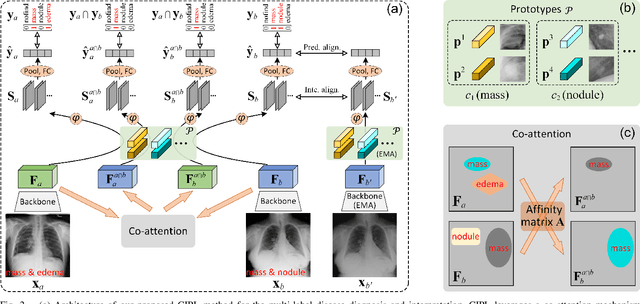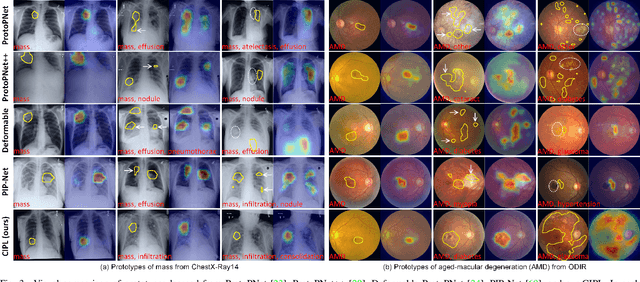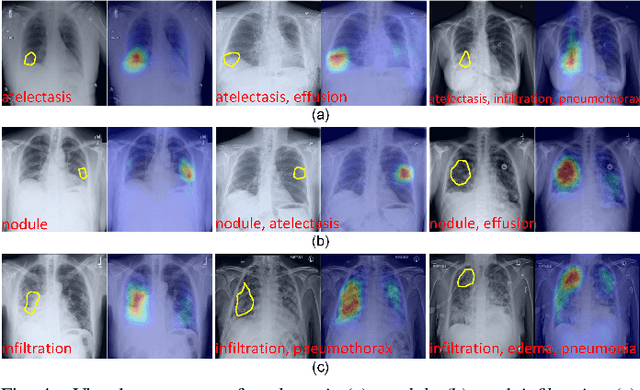Gustavo Carneiro
Australian Institute for Machine Learning
Risk Estimation of Knee Osteoarthritis Progression via Predictive Multi-task Modelling from Efficient Diffusion Model using X-ray Images
Jun 17, 2025Abstract:Medical imaging plays a crucial role in assessing knee osteoarthritis (OA) risk by enabling early detection and disease monitoring. Recent machine learning methods have improved risk estimation (i.e., predicting the likelihood of disease progression) and predictive modelling (i.e., the forecasting of future outcomes based on current data) using medical images, but clinical adoption remains limited due to their lack of interpretability. Existing approaches that generate future images for risk estimation are complex and impractical. Additionally, previous methods fail to localize anatomical knee landmarks, limiting interpretability. We address these gaps with a new interpretable machine learning method to estimate the risk of knee OA progression via multi-task predictive modelling that classifies future knee OA severity and predicts anatomical knee landmarks from efficiently generated high-quality future images. Such image generation is achieved by leveraging a diffusion model in a class-conditioned latent space to forecast disease progression, offering a visual representation of how particular health conditions may evolve. Applied to the Osteoarthritis Initiative dataset, our approach improves the state-of-the-art (SOTA) by 2\%, achieving an AUC of 0.71 in predicting knee OA progression while offering ~9% faster inference time.
CLOC: Contrastive Learning for Ordinal Classification with Multi-Margin N-pair Loss
Apr 22, 2025Abstract:In ordinal classification, misclassifying neighboring ranks is common, yet the consequences of these errors are not the same. For example, misclassifying benign tumor categories is less consequential, compared to an error at the pre-cancerous to cancerous threshold, which could profoundly influence treatment choices. Despite this, existing ordinal classification methods do not account for the varying importance of these margins, treating all neighboring classes as equally significant. To address this limitation, we propose CLOC, a new margin-based contrastive learning method for ordinal classification that learns an ordered representation based on the optimization of multiple margins with a novel multi-margin n-pair loss (MMNP). CLOC enables flexible decision boundaries across key adjacent categories, facilitating smooth transitions between classes and reducing the risk of overfitting to biases present in the training data. We provide empirical discussion regarding the properties of MMNP and show experimental results on five real-world image datasets (Adience, Historical Colour Image Dating, Knee Osteoarthritis, Indian Diabetic Retinopathy Image, and Breast Carcinoma Subtyping) and one synthetic dataset simulating clinical decision bias. Our results demonstrate that CLOC outperforms existing ordinal classification methods and show the interpretability and controllability of CLOC in learning meaningful, ordered representations that align with clinical and practical needs.
AI-Powered Prediction of Nanoparticle Pharmacokinetics: A Multi-View Learning Approach
Mar 18, 2025Abstract:The clinical translation of nanoparticle-based treatments remains limited due to the unpredictability of (nanoparticle) NP pharmacokinetics$\unicode{x2014}$how they distribute, accumulate, and clear from the body. Predicting these behaviours is challenging due to complex biological interactions and the difficulty of obtaining high-quality experimental datasets. Existing AI-driven approaches rely heavily on data-driven learning but fail to integrate crucial knowledge about NP properties and biodistribution mechanisms. We introduce a multi-view deep learning framework that enhances pharmacokinetic predictions by incorporating prior knowledge of key NP properties such as size and charge into a cross-attention mechanism, enabling context-aware feature selection and improving generalization despite small datasets. To further enhance prediction robustness, we employ an ensemble learning approach, combining deep learning with XGBoost (XGB) and Random Forest (RF), which significantly outperforms existing AI models. Our interpretability analysis reveals key physicochemical properties driving NP biodistribution, providing biologically meaningful insights into possible mechanisms governing NP behaviour in vivo rather than a black-box model. Furthermore, by bridging machine learning with physiologically based pharmacokinetic (PBPK) modelling, this work lays the foundation for data-efficient AI-driven drug discovery and precision nanomedicine.
Set a Thief to Catch a Thief: Combating Label Noise through Noisy Meta Learning
Feb 22, 2025Abstract:Learning from noisy labels (LNL) aims to train high-performance deep models using noisy datasets. Meta learning based label correction methods have demonstrated remarkable performance in LNL by designing various meta label rectification tasks. However, extra clean validation set is a prerequisite for these methods to perform label correction, requiring extra labor and greatly limiting their practicality. To tackle this issue, we propose a novel noisy meta label correction framework STCT, which counterintuitively uses noisy data to correct label noise, borrowing the spirit in the saying ``Set a Thief to Catch a Thief''. The core idea of STCT is to leverage noisy data which is i.i.d. with the training data as a validation set to evaluate model performance and perform label correction in a meta learning framework, eliminating the need for extra clean data. By decoupling the complex bi-level optimization in meta learning into representation learning and label correction, STCT is solved through an alternating training strategy between noisy meta correction and semi-supervised representation learning. Extensive experiments on synthetic and real-world datasets demonstrate the outstanding performance of STCT, particularly in high noise rate scenarios. STCT achieves 96.9% label correction and 95.2% classification performance on CIFAR-10 with 80% symmetric noise, significantly surpassing the current state-of-the-art.
Leveraging Labelled Data Knowledge: A Cooperative Rectification Learning Network for Semi-supervised 3D Medical Image Segmentation
Feb 17, 2025Abstract:Semi-supervised 3D medical image segmentation aims to achieve accurate segmentation using few labelled data and numerous unlabelled data. The main challenge in the design of semi-supervised learning methods consists in the effective use of the unlabelled data for training. A promising solution consists of ensuring consistent predictions across different views of the data, where the efficacy of this strategy depends on the accuracy of the pseudo-labels generated by the model for this consistency learning strategy. In this paper, we introduce a new methodology to produce high-quality pseudo-labels for a consistency learning strategy to address semi-supervised 3D medical image segmentation. The methodology has three important contributions. The first contribution is the Cooperative Rectification Learning Network (CRLN) that learns multiple prototypes per class to be used as external knowledge priors to adaptively rectify pseudo-labels at the voxel level. The second contribution consists of the Dynamic Interaction Module (DIM) to facilitate pairwise and cross-class interactions between prototypes and multi-resolution image features, enabling the production of accurate voxel-level clues for pseudo-label rectification. The third contribution is the Cooperative Positive Supervision (CPS), which optimises uncertain representations to align with unassertive representations of their class distributions, improving the model's accuracy in classifying uncertain regions. Extensive experiments on three public 3D medical segmentation datasets demonstrate the effectiveness and superiority of our semi-supervised learning method.
Coverage-Constrained Human-AI Cooperation with Multiple Experts
Nov 18, 2024Abstract:Human-AI cooperative classification (HAI-CC) approaches aim to develop hybrid intelligent systems that enhance decision-making in various high-stakes real-world scenarios by leveraging both human expertise and AI capabilities. Current HAI-CC methods primarily focus on learning-to-defer (L2D), where decisions are deferred to human experts, and learning-to-complement (L2C), where AI and human experts make predictions cooperatively. However, a notable research gap remains in effectively exploring both L2D and L2C under diverse expert knowledge to improve decision-making, particularly when constrained by the cooperation cost required to achieve a target probability for AI-only selection (i.e., coverage). In this paper, we address this research gap by proposing the Coverage-constrained Learning to Defer and Complement with Specific Experts (CL2DC) method. CL2DC makes final decisions through either AI prediction alone or by deferring to or complementing a specific expert, depending on the input data. Furthermore, we propose a coverage-constrained optimisation to control the cooperation cost, ensuring it approximates a target probability for AI-only selection. This approach enables an effective assessment of system performance within a specified budget. Also, CL2DC is designed to address scenarios where training sets contain multiple noisy-label annotations without any clean-label references. Comprehensive evaluations on both synthetic and real-world datasets demonstrate that CL2DC achieves superior performance compared to state-of-the-art HAI-CC methods.
Fair Distillation: Teaching Fairness from Biased Teachers in Medical Imaging
Nov 18, 2024



Abstract:Deep learning has achieved remarkable success in image classification and segmentation tasks. However, fairness concerns persist, as models often exhibit biases that disproportionately affect demographic groups defined by sensitive attributes such as race, gender, or age. Existing bias-mitigation techniques, including Subgroup Re-balancing, Adversarial Training, and Domain Generalization, aim to balance accuracy across demographic groups, but often fail to simultaneously improve overall accuracy, group-specific accuracy, and fairness due to conflicts among these interdependent objectives. We propose the Fair Distillation (FairDi) method, a novel fairness approach that decomposes these objectives by leveraging biased ``teacher'' models, each optimized for a specific demographic group. These teacher models then guide the training of a unified ``student'' model, which distills their knowledge to maximize overall and group-specific accuracies, while minimizing inter-group disparities. Experiments on medical imaging datasets show that FairDi achieves significant gains in both overall and group-specific accuracy, along with improved fairness, compared to existing methods. FairDi is adaptable to various medical tasks, such as classification and segmentation, and provides an effective solution for equitable model performance.
Rethinking Weight-Averaged Model-merging
Nov 14, 2024Abstract:Weight-averaged model-merging has emerged as a powerful approach in deep learning, capable of enhancing model performance without fine-tuning or retraining. However, the underlying mechanisms that explain its effectiveness remain largely unexplored. In this paper, we investigate this technique from three novel perspectives to provide deeper insights into how and why weight-averaged model-merging works: (1) we examine the intrinsic patterns captured by the learning of the model weights, through the visualizations of their patterns on several datasets, showing that these weights often encode structured and interpretable patterns; (2) we investigate model ensemble merging strategies based on averaging on weights versus averaging on features, providing detailed analyses across diverse architectures and datasets; and (3) we explore the impact on model-merging prediction stability in terms of changing the parameter magnitude, revealing insights into the way of weight averaging works as regularization by showing the robustness across different parameter scales. Our findings shed light on the "black box" of weight-averaged model-merging, offering valuable insights and practical recommendations that advance the model-merging process.
Cross- and Intra-image Prototypical Learning for Multi-label Disease Diagnosis and Interpretation
Nov 07, 2024



Abstract:Recent advances in prototypical learning have shown remarkable potential to provide useful decision interpretations associating activation maps and predictions with class-specific training prototypes. Such prototypical learning has been well-studied for various single-label diseases, but for quite relevant and more challenging multi-label diagnosis, where multiple diseases are often concurrent within an image, existing prototypical learning models struggle to obtain meaningful activation maps and effective class prototypes due to the entanglement of the multiple diseases. In this paper, we present a novel Cross- and Intra-image Prototypical Learning (CIPL) framework, for accurate multi-label disease diagnosis and interpretation from medical images. CIPL takes advantage of common cross-image semantics to disentangle the multiple diseases when learning the prototypes, allowing a comprehensive understanding of complicated pathological lesions. Furthermore, we propose a new two-level alignment-based regularisation strategy that effectively leverages consistent intra-image information to enhance interpretation robustness and predictive performance. Extensive experiments show that our CIPL attains the state-of-the-art (SOTA) classification accuracy in two public multi-label benchmarks of disease diagnosis: thoracic radiography and fundus images. Quantitative interpretability results show that CIPL also has superiority in weakly-supervised thoracic disease localisation over other leading saliency- and prototype-based explanation methods.
ANNE: Adaptive Nearest Neighbors and Eigenvector-based Sample Selection for Robust Learning with Noisy Labels
Nov 03, 2024Abstract:An important stage of most state-of-the-art (SOTA) noisy-label learning methods consists of a sample selection procedure that classifies samples from the noisy-label training set into noisy-label or clean-label subsets. The process of sample selection typically consists of one of the two approaches: loss-based sampling, where high-loss samples are considered to have noisy labels, or feature-based sampling, where samples from the same class tend to cluster together in the feature space and noisy-label samples are identified as anomalies within those clusters. Empirically, loss-based sampling is robust to a wide range of noise rates, while feature-based sampling tends to work effectively in particular scenarios, e.g., the filtering of noisy instances via their eigenvectors (FINE) sampling exhibits greater robustness in scenarios with low noise rates, and the K nearest neighbor (KNN) sampling mitigates better high noise-rate problems. This paper introduces the Adaptive Nearest Neighbors and Eigenvector-based (ANNE) sample selection methodology, a novel approach that integrates loss-based sampling with the feature-based sampling methods FINE and Adaptive KNN to optimize performance across a wide range of noise rate scenarios. ANNE achieves this integration by first partitioning the training set into high-loss and low-loss sub-groups using loss-based sampling. Subsequently, within the low-loss subset, sample selection is performed using FINE, while the high-loss subset employs Adaptive KNN for effective sample selection. We integrate ANNE into the noisy-label learning state of the art (SOTA) method SSR+, and test it on CIFAR-10/-100 (with symmetric, asymmetric and instance-dependent noise), Webvision and ANIMAL-10, where our method shows better accuracy than the SOTA in most experiments, with a competitive training time.
 Add to Chrome
Add to Chrome Add to Firefox
Add to Firefox Add to Edge
Add to Edge